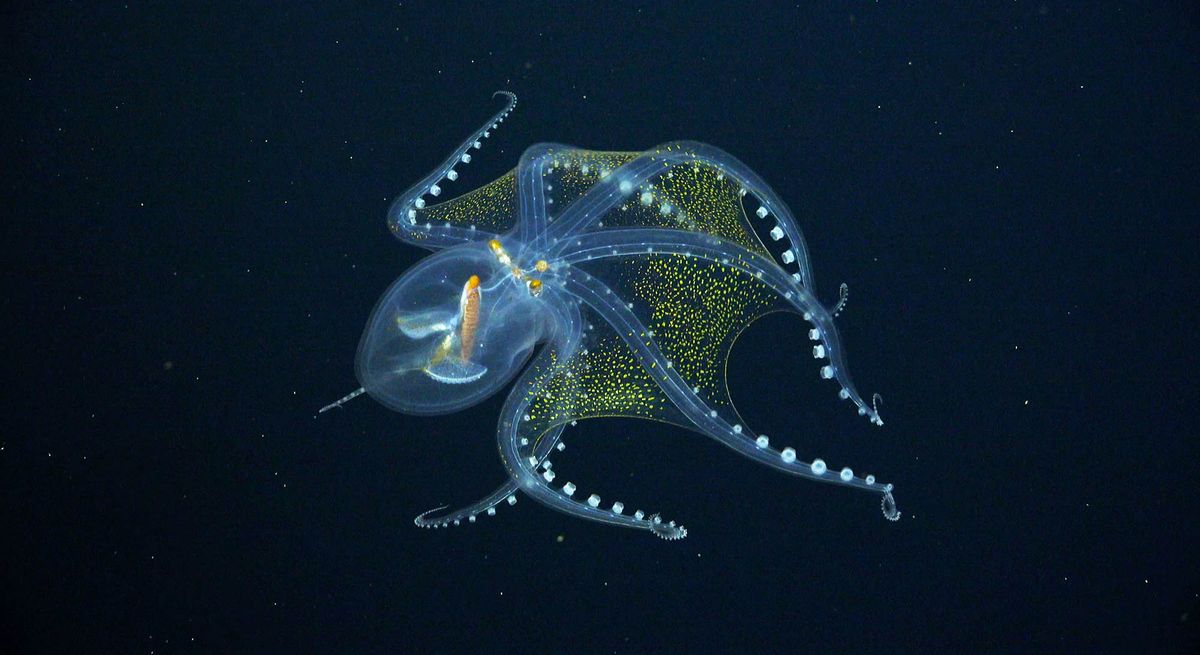Completely translucent but for a few specks of yellow-hued organs, a rare glass octopus made its debut on a live recording captured by scientists aboard the Schmidt Ocean Institute’s research vessel Falkor in July 2021.
And after footage of the glass octopus went viral online, the exploration agency took to social media on July 10 to “clear up” facts about the deep-sea animal.
Spotted at a depth of over 2,100 feet at an underwater mountain known as a Seamount, relatively little is known about the species known scientifically as Vitreledonella richardi. This is in large part due to its deep marine home — most of what is known about V. richardi has been deduced by specimens found in the stomachs of its predators. Very few records exist and until now, there has been limited footage of the glass octopus.
“The Ocean holds wonders and promises we haven’t even imagined, much less discovered,” said Wendy Schmidt, co-founder of Schmidt Ocean Institute, in a news release. “Expeditions like these teach us why we need to increase our efforts to restore and better understand marine ecosystems everywhere — because the great chain of life that begins in the ocean is critical for human health and wellbeing.”
The footage was captured by E/V Falkor, a research vessel operated by the Schmidt Ocean Institute that conducts mapping surveys, collects live video footage, and conducts experiments to better understand the marine world. The vessel was exploring the Winslow reef complex on Tokelau Ridge in Phoenix Islands Archipelago, a remote region in the South Pacific about halfway between Hawaii and Fiji. This group of eight atolls and two submerged coral reefs encompasses a protected area that measures about the size of California and is rife with a diversity of marine life.
Among the many species captured on live video were two sightings of glass octopuses, which the World Register of Marine Species noted was first described by Parisian marine biologist Louis Joubin in 1918. The pelagic octopus swims through the ocean far above the seafloor and is thought to be one of the least studied cephalopods, largely because the animal is so elusive, according to a 2016 study published in the journal Marine Biodiversity Records. So named for its nearly transparent body, the only features of the octopus that are not clear are the optic nerve, eyeballs, and digestive tract. Additionally, cells known as chromatophores use pigmentation to create color for camouflage and can be seen in the video in the form of yellow dots throughout the web and arms of the animal.
https://www.youtube.com/watch?v=dvG2GdxKfiQ&t=35175s
The International Union for Conservation of Nature classified the glass octopus as a species of “least concern.” With a mantle that can reach up to 4.3 inches for a total length of about 18 inches from tip to arm, the deep-sea cephalopod is also characterized by its elongated eyes that look rectangular from one side. With a lens at one end and a retina on the other, this unique eyeball makeup paired with its transparent body cast a small shadow to predators below.
“Working with scientists and local researchers, this expedition is a remarkable example of the frontiers of science and exploration that we are able to support,” said Jyotika Virmani, executive director of Schmidt Ocean Institute. “Live-streaming the dives gives us a glimpse of rarely seen and fascinating creatures such as the transparent glass octopus. By providing this platform to further the understanding of our ocean, we trigger the imagination while helping to push forward scientific insights and the protection of our underwater world.”

